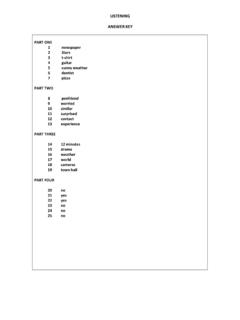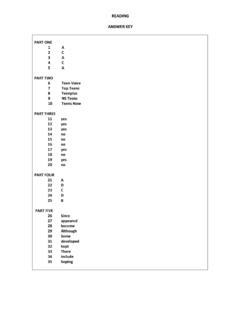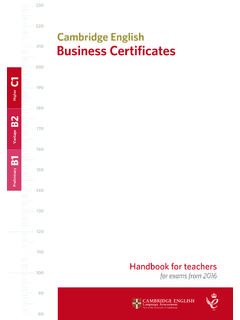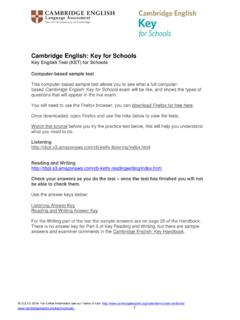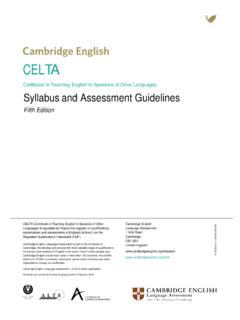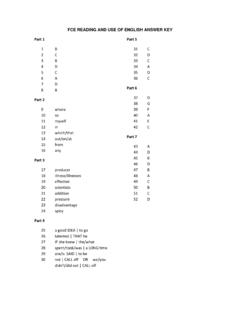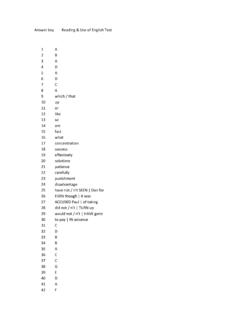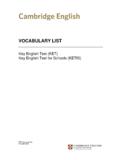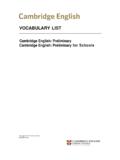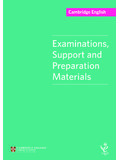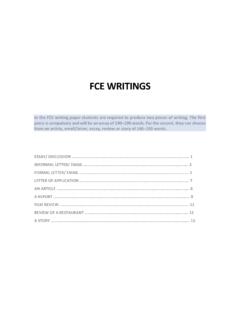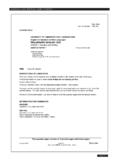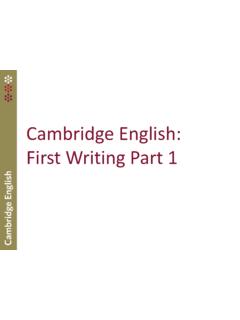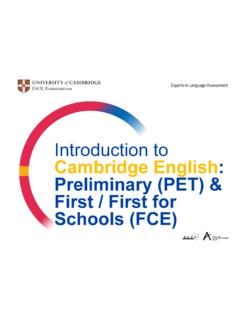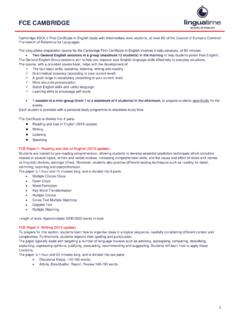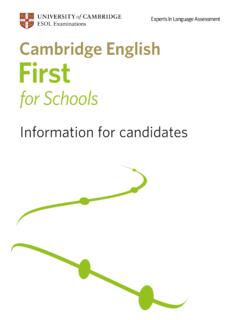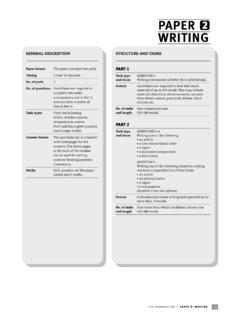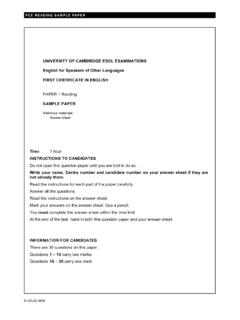Transcription of Cambridge English: First for Schools Writing Paper Part 2
1 UCLES 2016. For further information see our Terms of Use at 1 Cambridge English: First for Schools Writing Paper Part 2 Aims of the lesson To familiarise students with the text types in Part 2 of the Writing Test Time needed 50 - 60 minutes Materials required Student worksheet 1 cut up (1 per ten students) Student worksheets 2 and 3 (1 per student) Student worksheet 4 (1 per student) Procedure 1. Before the class, photocopy Student s worksheet 1 and cut it up so that each student can have either the name of a text type or an example of a text type.
2 2. Tell the st udents that there are five different task types they may be expected to produce in Part 2, and that you are going to look at them briefly in this activi ty. Remind or tell them that they only have to write one task in Part 2, and that they can choose one out of questions 2 4, or a set text question. 3. If there are more than ten students, divide the students into two or three groups which will mingle in different areas of the cl assroom and distribute the pieces of Paper fr om Student s worksheet 1 evenly between the students. Some students may have to have more than one piece of Paper and find more than one partner.
3 4. Students either have the name of a text type, or an example of a text. They have to find a partner with whom they can match the extract with the text type. They are all task types that candidates may be required to write in Part 2 of the Cambridge English: First for Schools Writing Paper . Alternative to 3. and 4.: if you have a lot of students and mingling is difficult, simply cut up the cards into sets and give them out to the students in groups of three or four. The students match the pairs. 5. When students have found their partner(s) , in their groups st udents lay out the strips so that each task type matches an example, and: i) agree as a group that each pairing is correct.
4 Ii) decide what the task for each text is ( a review of a film, a letter of advice to a fr iend about going on a trip, etc.) UCLES 2016. For further information see our Terms of Use at 2 6. Feed back some ideas with the whole class (see Answer key). If appropriate, draw attention to features of the text which give you information about the target reader (audience) of the text. 7. Give students a copy of the sample material -. Ask students to work in pairs and identify the text types that candidates are required to write for each question. Get them to choose their First choice of question and their last choice and discuss the reasons for their choices with their partner.
5 (Text types: 2 letter; 3 review; 4 story; 5 essay). 8. Get feedback from students about why they like certain questions and why they dislike other questions. Elicit the fact that with a plan of how to write a text and with practice students may be able to gain confidence with a particular question. There is obviously no correct answer to this. However, I think reviews are seen as difficult when in fact they are not. This is because we give reviews all the time when talking with friends about the latest video game, film and so on. Plus, the language of reviews is quite formulaic and can is repeated in most reviews.
6 9. Give the example of the story question (question 4) and ask students for some ideas on how they would go about Writing the answer to this question. Point out/elicit that the main reason for Writing would be to get the interest of the reader. When Writing a st ory, you have to find inspiration and details to make your story colourful and interest ing for the reader. 10. Give out Student s worksheet 3 and ask students to complete it in pairs. When they have finished, elicit feedback from the whole class (see Answer key below). 11. Do students feel that this advice on story Writing would help them tackle the story question in the sample Paper (question 4)?
7 Tell them that a nice alternative to planning a story in the traditional paragraph structure way is to decide the events and put them on a timeline. This has the advantage of making the choice of tenses easier. If they need to jump back in time to refer to earlier events to explain why, for example, the boy had somebody else s suitcase, it will be easier to know to describe these using past perfect tenses. Control of narrative tenses is an important aspect of story Writing and something the examiner pays special attention to. 12. If time, hand out Student s worksheet 4 and ask students to quickly read the text for the main idea.
8 Next ask them to put the verbs into the correct tense. After a few minutes check to see if they were correct (see Answer key below). It is based on the story from Student worksheet 1. This will give you an idea if the class need extra help with narrative tenses. 13. Next ask them to look at the words in italics. Tell them that the words are fine and ask them what the problem is. The answer is that they are boring vocabulary. Give the students 2 minutes to try to think of more interesting alternatives (see Answer key). During feedback tell them that this is an important part of checking any Writing and encourage them to do it.
9 UCLES 2016. For further information see our Terms of Use at 3 14. Next ask them to look at the gaps. Ask the student what type of words goes in the gaps, the answer is adverbs and time phrases. Do the First one as an example and ask the class to try to fill in the other gaps. During feedback (see Answer key) tell them that this is an important part of checking Writing and encourage them to do it. 15. For homework ask the class to write the story from the sample Paper . Additional information For more information about assessment criteria, see the Cambridge English: First for Schools (FCE for Schools ) Handbook.
10 For more information on the set text questions, see the Cambridge English: First for Schools Handbook. Reading the set text in cl ass increases students options in the Writing Paper . It s also possible to use the film version of the se t text if this is preferred. If you are not st udying the set text, make sure the students know that if they choose question 5, they should know the book or the film as they must refer to it in their answer. They might know it in their own language, which is fine, but they must know something about it in order to write a relevant answer.
